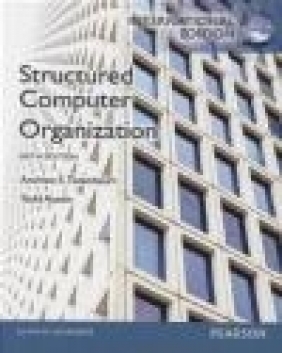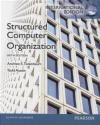Structured Computer Organization
Todd Austin, Andrew Tanenbaum
Structured Computer Organization
Todd Austin, Andrew Tanenbaum
- Producent: Pearson
- Rok produkcji: 2012
- ISBN: 9780273769248
- Ilość stron: 800
- Oprawa: Miękka
Niedostępna
Opis: Structured Computer Organization - Todd Austin, Andrew Tanenbaum
Structured Computer Organization, specifically written for undergraduate students, is a best-selling guide that provides an accessible introduction to computer hardware and architecture. This text will also serve as a useful resource for all computer professionals and engineers who need an overview or introduction to computer architecture. This book takes a modern structured, layered approach to understanding computer systems. It's highly accessible - and it's been thoroughly updated to reflect today's most critical new technologies and the latest developments in computer organization and architecture. Tanenbaum's renowned writing style and painstaking research make this one of the most accessible and accurate books available, maintaining the author's popular method of presenting a computer as a series of layers, each one built upon the ones below it, and understandable as a separate entity.CHAPTER 1 INTRODUCTION 1.1 STRUCTURED COMPUTER ORGANIZATION 1.1.1 Languages, Levels, and Virtual Machines 1.1.2 Contemporary Multilevel Machines 1.1.3 Evolution of Multilevel Machines 1.2 MILESTONES IN COMPUTER ARCHITECTURE 1.2.1 The Zeroth Generation (Mechanical Computers (1642-1945)) 1.2.2 The First Generation (Vacuum Tubes (1945-1955)) 1.2.3 The Second Generation (Transistors (1955-1965)) 1.2.4 The Third Generation (Integrated Circuits (1965-1980)) 1.2.5 The Fourth Generation (Very Large Scale Integration (1980-?)) 1.2.6 The Fifth Generation (Low-Power and Invisible Computers) 1.3 THE COMPUTER ZOO 1.3.1 Technological and Economic Forces 1.3.2 The Computer Spectrum 1.3.3 Disposable Computers 1.3.4 Microcontrollers 1.3.5 Mobile and Game Computers 1.3.6 Personal Computers 1.3.7 Servers 1.3.8 Mainframes 1.4 EXAMPLE COMPUTER FAMILIES 1.4.1 Introduction to the x86 Architecture 1.4.2 Introduction to the ARM Architecture 1.4.3 Introduction to the AVR Architecture 1.5 METRIC UNITS 1.6 OUTLINE OF THIS BOOK CHAPTER 2 COMPUTER SYSTEMS ORGANIZATION 2.1 PROCESSORS 2.1.1 CPU Organization 2.1.2 Instruction Execution 2.1.3 RISC versus CISC 2.1.4 Design Principles for Modern Computers 2.1.5 Instruction-Level Parallelism 2.1.6 Processor-Level Parallelism 2.2 PRIMARY MEMORY 2.2.1 Bits 2.2.2 Memory Addresses 2.2.3 Byte Ordering 2.2.4 Error-Correcting Codes 2.2.5 Cache Memory 2.2.6 Memory Packaging and Types 2.3 SECONDARY MEMORY 2.3.1 Memory Hierarchies 2.3.2 Magnetic Disks 2.3.3 IDE Disks 2.3.4 SCSI Disks 2.3.5 RAID 2.3.6 Solid-State Disks 2.3.7 CD-ROMs 2.3.8 CD-Recordables 2.3.9 CD-Rewritables 2.3.10 DVD 2.3.11 Blu-ray 2.4 INPUT/OUTPUT 2.4.1 Buses 2.4.2 Terminals 2.4.3 Mice 2.4.4 Game Controllers 2.4.5 Printers 2.4.6 Telecommunications Equipment 2.4.7 Digital Cameras 2.4.8 Character Codes 2.5 SUMMARY CHAPTER 3 THE DIGITAL LOGIC LEVEL 3.1 GATES AND BOOLEAN ALGEBRA 3.1.1 Gates 3.1.2 Boolean Algebra 3.1.3 Implementation of Boolean Functions 3.1.4 Circuit Equivalence 3.2 BASIC DIGITAL LOGIC CIRCUITS 3.2.1 Integrated Circuits 3.2.2 Combinational Circuits 3.2.3 Arithmetic Circuits 3.2.4 Clocks 3.3 MEMORY 3.3.1 Latches 3.3.2 Flip-Flops 3.3.3 Registers 3.3.4 Memory Organization 3.3.5 Memory Chips 3.3.6 RAMs and ROMs 3.4 CPU CHIPS AND BUSES 3.4.1 CPU Chips 3.4.2 Computer Buses 3.4.3 Bus Width 3.4.4 Bus Clocking 3.4.5 Bus Arbitration 3.4.6 Bus Operations 3.5 EXAMPLE CPU CHIPS 3.5.1 The Intel Core i7 3.5.2 The Texas Instruments OMAP4430 System-on-a-Chip 3.5.3 The Atmel ATmega168 Microcontroller 3.6 EXAMPLE BUSES 3.6.1 The PCI Bus 3.6.2 PCI Express 3.6.3 The Universal Serial Bus 3.7 INTERFACING 3.7.1 I/O Interfaces 3.7.2 Address Decoding 3.8 SUMMARY CHAPTER 4 THE MICROARCHITECTURE LEVEL 4.1 AN EXAMPLE MICROARCHITECTURE 4.1.1 The Data Path 4.1.2 Microinstructions 4.1.3 Microinstruction Control: The Mic-1 4.2 AN EXAMPLE ISA: IJVM 4.2.1 Stacks 4.2.2 The IJVM Memory Model 4.2.3 The IJVM Instruction Set 4.2.4 Compiling Java to IJVM 4.3 AN EXAMPLE IMPLEMENTATION 4.3.1 Microinstructions and Notation 4.3.2 Implementation of IJVM Using the Mic-1 4.4 DESIGN OF THE MICROARCHITECTURE LEVEL 4.4.1 Speed versus Cost 4.4.2 Reducing the Execution Path Length 4.4.3 A Design with Prefetching: The Mic-2 4.4.4 A Pipelined Design: The Mic-3 4.4.5 A Seven-Stage Pipeline: The Mic-4 4.5 IMPROVING PERFORMANCE 4.5.1 Cache Memory 4.5.2 Branch Prediction 4.5.3 Out-of-Order Execution and Register Renaming 4.5.4 Speculative Execution 4.6 EXAMPLES OF THE MICROARCHITECTURE LEVEL 4.6.1 The Microarchitecture of the Core i7 CPU 4.6.2 The Microarchitecture of the OMAP4430 CPU 4.6.3 The Microarchitecture of the ATmega168 Microcontroller 4.7 COMPARISON OF THE CORE I7, OMAP4430, AND ATMEGA168 4.8 SUMMARY CHAPTER 5 THE INSTRUCTION SET ARCHITECTURE LEVEL 5.1 OVERVIEW OF THE ISA LEVEL 5.1.1 Properties of the ISA Level 5.1.2 Memory Models 5.1.3 Registers 5.1.4 Instructions 5.1.5 Overview of the ARM ISA Level 5.1.6 Overview of the x86 ISA Level 5.1.7 Overview of the AVR Level 5.2 DATA TYPES 5.2.1 Numeric Data Types 5.2.2 Nonnumeric Data Types 5.2.3 Data Types on the ARM 5.2.4 Data Types on the x86 5.2.5 Data Types on the AVR 5.3 INSTRUCTION FORMATS 5.3.1 Design Criteria for Instruction Formats 5.3.2 Expanding Opcodes 5.3.3 The ARM Instruction Formats 5.3.4 The x86 Instruction Formats 5.3.5 The AVR Instruction Formats 5.4 ADDRESSING 360 5.4.1 Addressing Modes 5.4.2 Immediate Addressing 5.4.3 Direct Addressing 5.4.4 Register Addressing 5.4.5 Register Indirect Addressing 5.4.6 Indexed Addressing 5.4.7 Based-Indexed Addressing 5.4.8 Stack Addressing 5.4.9 Addressing Modes for Branch Instructions 5.4.10 Orthogonality of Opcodes and Addressing Modes 5.4.11 The ARM Addressing Modes 5.4.12 The x86 Addressing Modes 5.4.13 The AVR Addressing Modes 5.4.14 Discussion of Addressing Modes 5.5 INSTRUCTION TYPES 5.5.1 Data Movement Instructions 5.5.2 Dyadic Operations 5.5.3 Monadic Operations 5.5.4 Comparisons and Conditional Branches 5.5.5 Procedure Call Instructions 5.5.6 Loop Control 5.5.7 Input/Output 5.5.8 The ARM Instructions 5.5.9 The x86 Instructions 5.5.10 The AVR Instructions 5.5.11 Comparison of Instruction Sets 5.6 FLOW OF CONTROL 5.6.1 Sequential Flow of Control and Branches 5.6.2 Procedures 5.6.3 Coroutines and Threads 5.6.5 Traps 5.6.5 Interrupts 5.7 A DETAILED EXAMPLE: THE TOWERS OF HANOI 5.7.1 The Towers of Hanoi in ARM Assembly Language 5.7.2 The Towers of Hanoi in x86 Assembly Language 5.8 THE NVIDIA Fermi Architecture 5.8.1 The Problem with the ARM and x86 Architectures 5.8.2 The Fermi Model: Massively Data-Parallel Computing 5.8.3 Regularizing Memory References 5.8.4 Thread Scheduling 5.8.5 Reducing Branch Divergence 5.9 SUMMARY CHAPTER 6 THE OPERATING SYSTEM MACHINE LEVEL 6.1 VIRTUAL MEMORY 6.1.1 Paging 6.1.2 Implementation of Paging 6.1.3 Demand Paging and the Working Set Model 6.1.4 Page Replacement Policy 6.1.5 Page Size and Fragmentation 6.1.6 Segmentation 6.1.7 Implementation of Segmentation 6.1.8 Virtual Memory on the ARM 6.1.9 Virtual Memory on the x86 6.1.10 Virtual Memory and Caching 6.2 VIRTUALIZATION 6.2.1 Why direct I/O hampers system design 6.2.2 Implementation of Virtual I/O access 6.2.3 Support for Virtualized I/O and Paging 6.2.4 IVT Virtualization in the x86 architecture 6.3 SUPPORT FOR PARALLEL PROCESSING 6.3.1 Process and Thread Creation 6.3.2 Race Conditions 6.3.3 Process Synchronization Using Semaphores and Barriers 6.4 EXAMPLE OPERATING SYSTEMS 6.4.1 Introduction 6.4.2 Examples of Virtual Memory 6.4.3 Examples of Virtualization 6.4.4 Examples of Process and Thread Management 6.5 SUMMARY CHAPTER 7 THE ASSEMBLY LANGUAGE LEVEL 7.1 INTRODUCTION TO ASSEMBLY LANGUAGE 7.1.1 What Is an Assembly Language? 7.1.2 Why Use Assembly Language? 7.1.3 Format of an Assembly Language Statement 7.1.4 Pseudoinstructions 7.2 MACROS 7.2.1 Macro Definition, Call, and Expansion 7.2.2 Macros with Parameters 7.2.3 Advanced Features 7.2.4 Implementation of a Macro Facility in an Assembler 7.3 THE ASSEMBLY PROCESS 7.3.1 Two-Pass Assemblers 7.3.2 Pass One 7.3.3 Pass Two 7.3.4 The Symbol Table 7.4 LINKING AND LOADING 7.4.1 Tasks Performed by the Linker 7.4.2 Structure of an Object Module 7.4.3 Binding Time and Dynamic Relocation 7.4.4 Dynamic Linking 7.5 SUMMARY CHAPTER 8 PARALLEL COMPUTER ARCHITECTURES 8.1 ON-CHIP PARALELLISM 8.1.1 Instruction-Level Parallelism 8.1.2 On-Chip Multithreading 8.1.3 Single-Chip Multiprocessors 8.2 Systems on a Chip (SoCs) 8.2.1 Network Processors 8.2.2 Media Processors 8.2.3 Cryptoprocessors 8.3 SHARED-MEMORY MULTIPROCESSORS 8.3.1 Multiprocessors vs. Multicomputers 8.3.2 Memory Semantics 8.3.3 UMA Symmetric Multiprocessor Architectures 8.3.4 NUMA Multiprocessors 8.3.5 COMA Multiprocessors 8.4 MESSAGE-PASSING MULTICOMPUTERS 8.4.1 Interconnection Networks 8.4.2 MPPs--Massively Parallel Processors 8.4.3 Cluster Computing 8.4.4 Communication Software for Multicomputers 8.4.5 Scheduling 8.4.6 Application-Level Shared Memory 8.4.7 Performance 8.5 GRID COMPUTING 8.6 SUMMARY CHAPTER 9 READING LIST AND BIBLIOGRAPHY 9.1 SUGGESTIONS FOR FURTHER READING 9.2 ALPHABETICAL BIBLIOGRAPHY
Producent:
GPSR Pearson Central Europe Sp. z o.o.
ul. Szamocka 8
01-748 Warszawa (PL)
tel: 459 596 060
email: [email protected]
Szczegóły: Structured Computer Organization - Todd Austin, Andrew Tanenbaum
Tytuł: Structured Computer Organization
Autor: Todd Austin, Andrew Tanenbaum
Producent: Pearson
ISBN: 9780273769248
Rok produkcji: 2012
Ilość stron: 800
Oprawa: Miękka
Waga: 1.22 kg





























